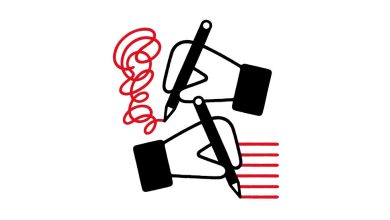When Did We All Become Pop Culture Detectives?

HALFWAY THROUGH LAST December, Britney Spears logged on to Instagram. A year had passed since the pop star was released from a 13-year conservatorship, thanks in part to the #FreeBritney movement, whose fastidious members suspected she’d been using the platform to send coded messages to her nearly 42 million followers. Now free to express herself, the 41-year-old singer shared an edited video aboard a private jet; a clip of Bette Davis flirting with a farmhand in the 1932 film “The Cabin in the Cotton”; and a two-slide carousel that included a top Google image search result for “Santa Claus + painting” and a recording of Spears and her husband, Sam Asghari, goofing around in front of a Christmas tree, with the caption, “He’s coming soon.”
One commenter surmised that Spears’s excitement about St. Nick’s arrival was in fact a veiled pregnancy announcement. Others trailed different, increasingly outrageous crumbs: What had happened to the gap between her two front teeth (which the would-be Britney Army attributed to dental decay, a possible side effect of the lithium she’d reportedly been forced to take against her will)? Why was the couple dressed in clothing they’d worn a few nights earlier on her birthday? Where was her wedding ring? And could it be a coincidence that when rearranged, the letters in “Santa” spell “Satan”? At least that would explain, added another conspiracist, why Spears was so often photographed giving Asghari devil horns.
Intense scrutiny has never been incidental to life as a public figure, but in our age of disinformation, when facts are fungible and nothing is what it seems, the discourse about celebrities and their work seems to have shifted from criticism to full-on forensics. Taylor Swift, an expert at lodging ciphers into her lyrics and liner notes, has trained her fans to comb her online content for clues about new music. “Thought you were slick, thinking this was your age. It’s not! I caught you!” said a breathless Swiftie on TikTok, still high from the dopamine hit of his discovery: He’d interpreted a photo of Swift taken on her 33rd birthday in December, in which she held up three fingers in each hand, as proof that the rerelease of “Speak Now,” her third record, was imminent; the purple filter she’d applied to the image, the same color as the dress she wore on the 2010 album’s cover, corroborated his suspicion.
Although Easter eggs — covert messages planted within books, video games, films, TV shows and songs, or on social media — are now part of the cultural fun, steganography began as an early fight for free speech. During the Middle Ages, when governing bodies were known to punish the creators of politically, socially or theologically disruptive literature, so-called heretics sometimes buried notes and phrases in text, or used invisible ink. In 1499, the first edition of “Hypnerotomachia Poliphili,” an unattributed erotic love story published in Venice, included an acrostic made by combining the first letter in each chapter, which, when translated into English, seemed to reveal the author’s identity.
A half-century later, the Netherlandish Renaissance painter Pieter Bruegel the Elder became known for embedding his crowded depictions of pastoral life with scatological humor, a crass antecedent to the English illustrator Martin Handford’s 1987 children’s book “Where’s Wally?” And while making “Rubber Soul” in 1965, the Beatles, inspired by the electronic manipulation of musique concrète from the 1940s, popularized backmasking, in which sound is recorded backward on a track. The technique’s use in the 1968 song “Revolution 9,” which created a line that sounded like “Turn me on, dead man,” fueled a rumor that Paul McCartney had been in a fatal car crash and replaced by a look-alike.
EASTER EGGS DIDN’T get their name until around 1980, when Warren Robinett, then a disenchanted Atari designer, frustrated that he hadn’t received public credit or royalties for his innovations, created a secret room in the video game Adventure where players could find his signature. Robinett remembers Steve Wright, the company’s director of software development at the time, saying, “Well, I don’t know that this is bad to have hidden surprises. It’s like waking up on Easter morning and searching for Easter eggs underneath the bushes and flowers.” (Decades later, the rebellious act inspired Ernest Cline’s 2011 sci-fi scavenger hunt novel, “Ready Player One.”)
Unlike an allusion — a tip of the hat to a previous work — an Easter egg, when found, is an anachronistic disruption, an anti-mimetic breaking of the fourth wall to make room for a joke, clue or grievance. And yet, as the search for clandestine meanings intensifies everywhere, the distinction has collapsed to include anything that lies just beneath the surface, and what was once the subtext — a stratum of fandom accessible only to the most loyal and discerning observers — has become the context.
Take “The White Lotus,” Mike White’s darkly comic anthology series for HBO, which finished its second season in December. Interest in the fate of its characters was stoked, if not sometimes eclipsed, by a quest led in real time by pop culture websites, podcasts and meme accounts to uncover its Easter eggs, actual and probable — from a voice cameo by Laura Dern, star of White’s “Enlightened” (2011-13), to the recurrence of a floral dress from the 1972 film “The Godfather” as foreshadowing. Then there’s Marvel, which has a long history of placing eggs as connective tissue across its universe — a flash of Captain America’s shield in the 2008 film “Iron Man,” for example — creating an appetite for crossovers and spinoffs.
As content floods our streaming devices, the Easter egg has become an increasingly popular marketing tool. In an interview about his Marvel series “WandaVision” (2021), the director Matt Shakman said, “Everyone has been watching the show under a microscope … And I love to see the fan theories.” Getting audiences to study a show, rather than simply watch it, helps keep the conversation going at a time when the shelf life for cultural works has become increasingly short.
Scouring for these narrative tricks is addictive — for one thing, they flatter consumers’ sense of themselves as nobody’s fool. In today’s media landscape, across the political spectrum, it can seem as if only dupes would take what they’re shown at strict face value. But the danger in searching for additional layers of meaning — another spool to unravel on Twitter or Reddit, whether it’s about an entertainer’s upcoming tour or the origins of the novel coronavirus — is that at some point you’re bound to find something that isn’t really there, or misinterpret what is.
Really, an Easter egg enthusiast is often just a conspiracy theorist with popcorn. Toeing the line between fandom and fanaticism, peering safely down the rabbit hole into the QAnonification of mainstream culture, can be thrilling. That is, until it’s not: A few days after her holiday post, Spears had seemingly had enough of the speculation, choosing to disable the comments on her Instagram account. Fans immediately took to other outlets like Reddit to weigh in on the decision, where a long scroll of supporters largely endorsed the idea. “Good,” wrote one of them. “Enough with the BAnon conspiracies.” Over on Twitter, though, not everyone was convinced. “Wasn’t her,” insisted a truther. “Was ‘her husband.’”




